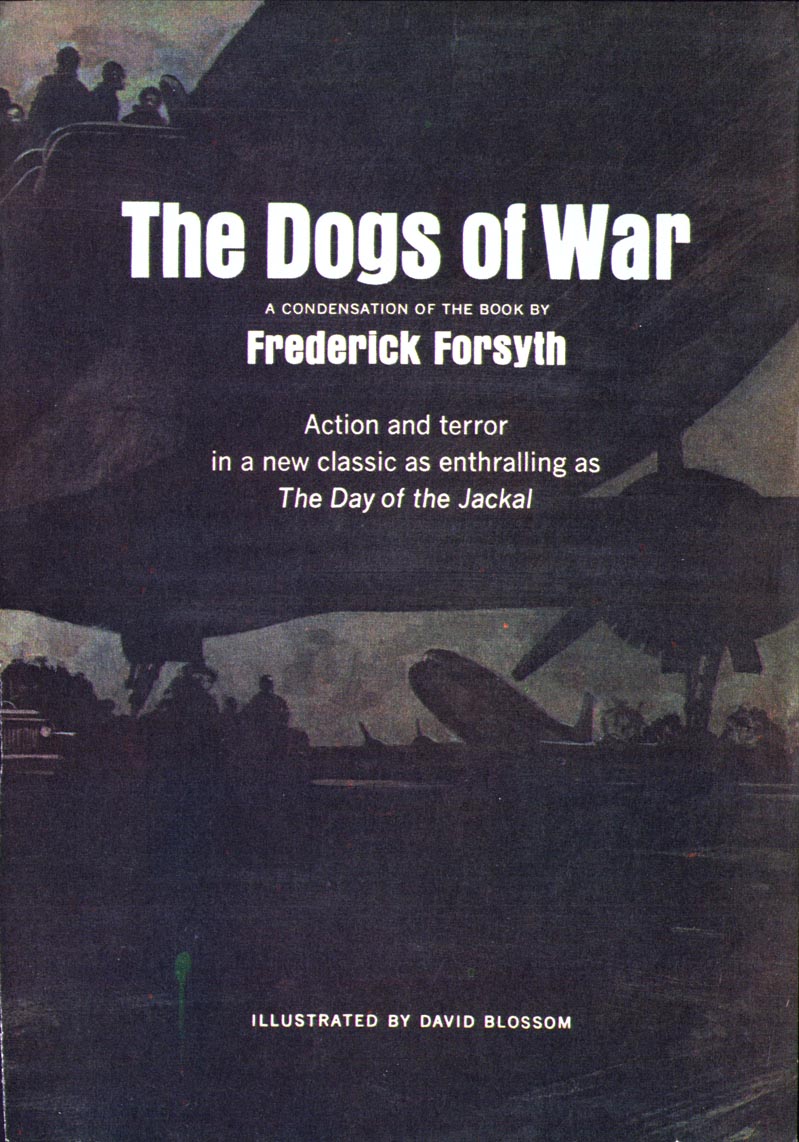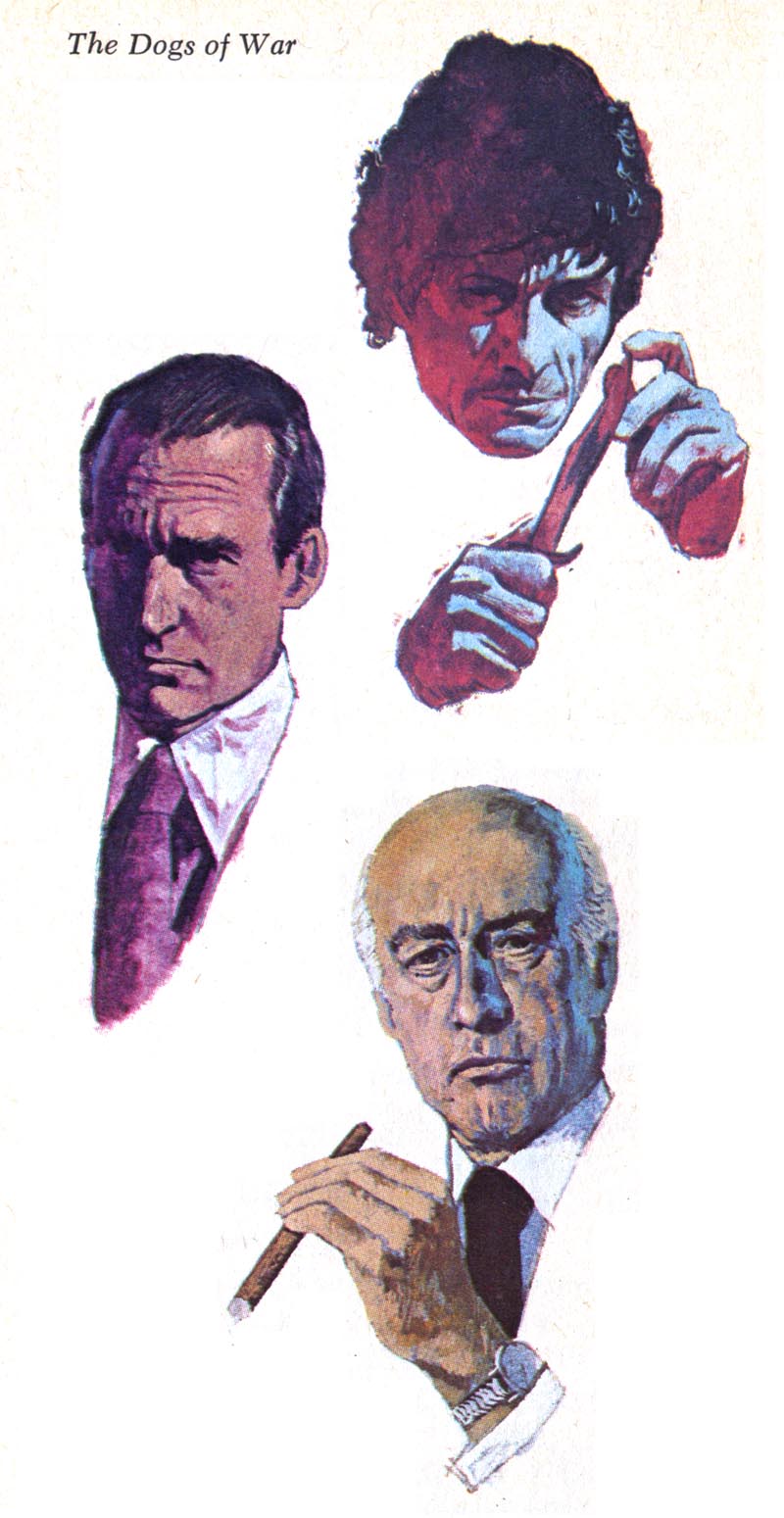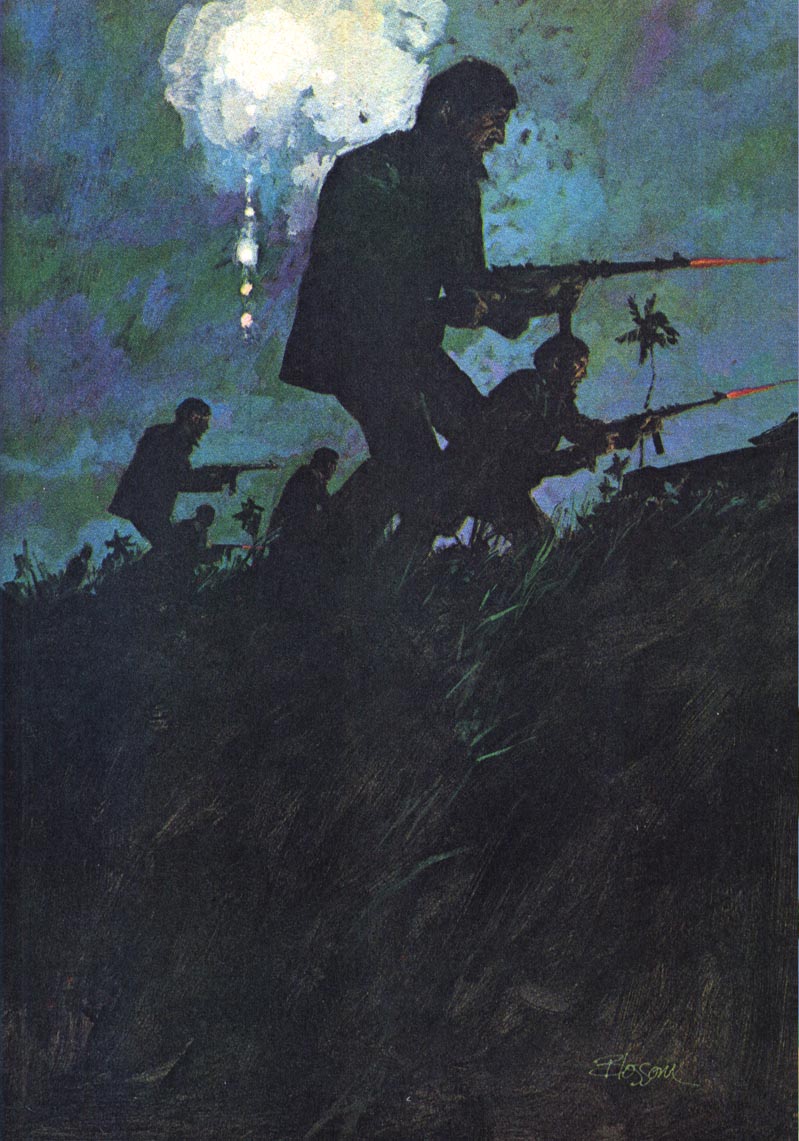
About a year ago, I received a note from Blossom's son, Peter:
"You don't have any of my dad's work, but you should! He was born in Chicago, Illinois but lived most of his life on the east coast, growing up in Rye, New York and Weston, Connecticut. He lived in Westport and Southport, Connecticut until 1963, when he moved with his family to Weston, where he lived until his death in 1995."

"He worked at Young & Rubicam as an art director (for the Ford Motor Company and Pan American Airways accounts) until moving to Weston, CT when he became a freelance illustrator. He created romance paperback book covers and Western themes (later in his career) and is also known for his movie posters (early Clint Eastwood spaghetti westerns, "The Good, The Bad, and The Ugly", "A Fistful of Dollars", and "A Few Dollars More" among others) and magazine covers. He was a regular cover (and interior) illustrator for Outdoor Life magazine and Reader's Digest, as well as many others."
* Note: today's series is from Reader's Digest Condensed Books - Leif

"David Blossom received the Society of Illustrator's Hamilton King Award for best illustration of the year by a member in 1973, and awards of excellence in the Society's annual shows."

"He was the son of Earl Blossom, an illustrator in the 1930's-'50's, the father of Christopher Blossom, a well-known marine artist, and also Peter Blossom, a graphic designer."
* This biography appears on askart.com

Peter adds, "I've been enjoying looking at your classic illustrations. They bring back a lot of memories of growing up, as my father was a contemporary and friend of a lot of the people you have in your classic illustrators archives."
With the help of Peter and his aunt (David Blossom's sister, Mary) I hope to bring you an entire week of posts on the magnificently talented artist some time soon!
* My David Blossom Flickr set.
excellent artist indeed, thanks for sharing!
ReplyDeleteGreat stuff! Looking forward to seeing more!
ReplyDeleteThe man in the last image looks remarkably like a young Bernie Fuchs. Timing is right. they could have been friends. And don't you love the frames on the art on the wall. So 50s-60s.
ReplyDeleteGood stuff! Any idea what Blossom's primary media was? Some looks like gouache, but I'm just not sure.
ReplyDeleteThank you all for your enthusiastic comments! Hugo, I'll ask Peter if his dad predominantly used one type of media. :^)
ReplyDeleteFirst Bob Foster, now David Blossom. Ok, now you're getting into territory that is tinged with one's real formative years. I remember alot of these pieces very well, but they are tied up with my adolescence, mostly from seeing them on the paperback racks at stores like Towers (anybody remember them?) or the occasional used book store, during those years when one knows they want a career in art and are trying to get a handle on what's out there. Alot of these seemed very.... weird, yet compelling, along side the Frazettas and Jeff Jones and Kelly Freas and other mainstream, yet not, illustrators. The explosion in the graphic arts, self publishing, special effects (Oscars for special effects/ oh, yeah, wasn't there that movie about the burning hotel...?) But that's just the memory of a kid growing up in a small southern Ontario town, where you had to make alot out of a little.
ReplyDeleteWhat were the chances of having a teacher like that? What must it have been like, to get a truly amazing art/illustration education? To find yourself at the feet of such a one.
Does it happen now?
That banner ad for Sheridan is disconcerting enough, let alone a reminder that you won't get any kind of an education as that described by Foster's student at any of our local art colleges or so called Universities.
OK, it's a comment turned into a memory turned into a rant, I'm sorry, lief, if this inappropriate for the comments section, then take it down,but there it is. It's something that i think about alot these days and I woul loke to see some dicussion on the topic. Are there any forums out there discussing this?
Wow!~ A fabulous comment, Scott - don't apologize. As a (VERY) recent addition to the faculty of a college that teaches Graphic Arts (Mohawk) I can tell you that there at least these foundation skills are being taught by a truly dedicated faculty of very capable instructors. The problem is multi-facetted though: the program is too short to invest all the time really required to learn, repeat, learn, repeat... students have so many other skills they need to acquire ( mostly mastering various software apps ) that it becomes impossible to find enough hours in the day.
ReplyDeleteI suspect you'd hear similar from instructors at other colleges.
Hopefully some will chime in! :^)
Just a great blog, Leif. First, I was about to inquire if David Blossom had done much in marine painting. So.... It's his son, Christopher Blossom. A very sharp marine artist. Quite unusual to have that many artists in a family....often kids want to go in a different direction. Agree....Scott Caple's remark is interesting and informative. Tom Watson's account of Bob Foster's teaching abilities sounded a whole lot better than I received at Art Center. Knowledgeable, illustration oriented, challenging, dedicated. Good and experienced teachers are rare indeed. Gracias again.
ReplyDeleteIt runs in the family. I'm David's granddaughter, Peter's daughter, and I also love to draw and paint.
DeleteLooking forward to more. Thanks to his son for sharing.
ReplyDeleteScott Caple, your astute question about being able to get a real illustration oriented education today, is one that I have been asked many times, over the past twenty years. I can only say that I think I was very lucky to have been at the right place at the right time, because I went on to two other very reputable art schools, Chouinard Art Institute and art Center School, both in L.A., and I never found another teacher that equalled Bob Foster's great teaching skills nor his talent, in my opinion. Barbara Bradley, who was also one of my illustration teachers at the same time, was also a very good teacher. However, she had a formal by-the-numbers approach, which wasn't as inspiring for me. It was a different style of teaching. Back then, each teacher taught their specialty, and illustration was still a potent industry that provided a lot of very good teachers. And, they taught because they wanted to pass on their knowledge and experience, not because it payed well.. which it really did not.
ReplyDeleteI think Leif is exactly right about teaching today. I experienced a similar dilemma, when I taught a decade ago, at the Academy of Art College in S.F.
Tom Watson
I was enthralled by Mr watson's account of his illustration training back in the 50s.I'd have loved to complete a course like that.
ReplyDeleteOnly problem is those days are gone.Even Mr Foster mostly missed out,and it's gotten a whole lot worse since then.We're talking about an industry that's dead on its feet,while we're surrounded by a primarily visual culture.Go figure.
Seeing these classic illustrators is truly inspiring but the sadness is that we'll never get the opportunity to do the same unless they uninvent the computer.
Gary; I'm delighted to read that you enjoyed Tom's recounting of his school days. But I encourage you to try to see the positives in the illustration industry today and not dwell too much on what came before, which you and I will never be able to participate in.
ReplyDeleteTake a quick look around the Internet and you'll discover that illustration is very much alive. The venue has changed - print may be dead or dying - but the need for talented artists and inspired illustration continues. Most of the work will probably never be seen by the public, mind you -- because most of it's now utilized in that broad category of "concept art". Give the site conceptart.org a visit and you'll be overwhelmed by the sheer volume of incredible painting and drawing - much of it executed in traditional media - and while, admittedly, much of the subject matter is skewed to the science fiction and fantasy enthusiast, consider that this was the case when artists like Bob Foster and his contemporaries hoped to make a living at illustration as well.
In the years ahead, as video games and Hollywood converge to an ever increasing degree, and as gamer culture and mainstream culture become one and the same, I believe you'll see more concept artists creating illustrations intended for a broader spectrum of tastes.
Part of what I think we need to appreciate is that everything is cyclical, and the trend toward illustration will come around again. Its hard to see how it will manifest exactly, but I am optimistic that illustration will be around (and be a robust and financially rewarding profession) for a very long time to come.
Hugo Sleestack, Peter Blossom writes:
ReplyDelete"...in response to Hugo Sleestak, he worked a lot in gouache and acrylic, sometimes oil."
Gee,Leif, I hope you're right about that.
ReplyDeleteThe mad thing is that when you do actually see illustrations given pride of place in a magazine, they so often give the article a kind of lift and a quality that a generic photograph just can't supply.
I'm sure there IS a league of morons out there running things these days.
Gary, by the late 1980's, I found work in areas that never existed before, as Leif is correctly predicting there will be more of illustration to be created somewhere in the future. For me, it was in the computer software companies, like Broaderbund and Mindscape.. and I didn't even have a computer at the time. In fact, it was being said that traditional illustrators were obsolete, because it could be done on the computer. Wrong! I did concepts, comp layouts and a lot of finished illustrations traditionally, for software programs that were being developed at a rapid rate. They were looking for artists that had the skills to adapt to different styles and a solid professional experience. They didn't care if I knew about computers. They wanted my traditional illustration knowledge.
ReplyDeleteThere are always opportunities, and today with the limitless Internet connections, you can network in ways we never dreamed of. It was all by phone, mail and literally lugging our samples from one potential client to another. It was often time consuming, tedious boring and discouraging to drum up one small assignment.. maybe. But, it was the best way to find work in a very fickle industry.
It's a giant pendulum that swings back and forth from photography to illustration, and it always has been. But, as you rightfully commented, we are a visual society, and quality art will never be dismissed, in my opinion. You just need to find that niche that is right for you. Studying the work of past illustrators, can and should be an inspiration, and a part of your education in helping to develop your capabilities, for today's market.
Keep your spirits up, and your pencil on the
drawing board. ;-)
Tom Watson
The second face is surely based on Oscar from the 6 Million Dollar Man?
ReplyDeleteHah... that's funny, Reece - he does look a lot like the Oscar character from 6MM. But no, Peter Blossom writes, "The bottom guy is another illustrator friend of my father's, Monnie Eisenberg. The middle guy is Ed Hall (not Bernie Fuchs). He was the Phys. Ed. teacher at Staples High School in Westport. My dad used him a lot."
ReplyDeleteLeif, thanks so much for forwarding my question - and for actually getting an answer! Much appreciated! I also appreciate your words to those of us out here who still use (or are back to using) what they call "natural media" these days. As someone who hopped on the digital train in the 1990's in a local design market and who has just jumped off to go to art school to REALLY learn how to draw and paint ... those are welcome words.
ReplyDeleteWe have two David Blossom illustrations being offered at our upcoming Larsen Art Auction on Saturday, October 26th, go to our website to see them as well as illustrations by Guy Deel and John Falter
ReplyDeleteAssignment Writing At expressbusinessdirectory
ReplyDeleteAssignment Writing Help UK At travelful
Assignment Help UK At place123
Assignment Help UK At iglobal
Essay Writing Help
Academic Writing Help
Assignment Help UK At Zbusinessfinder